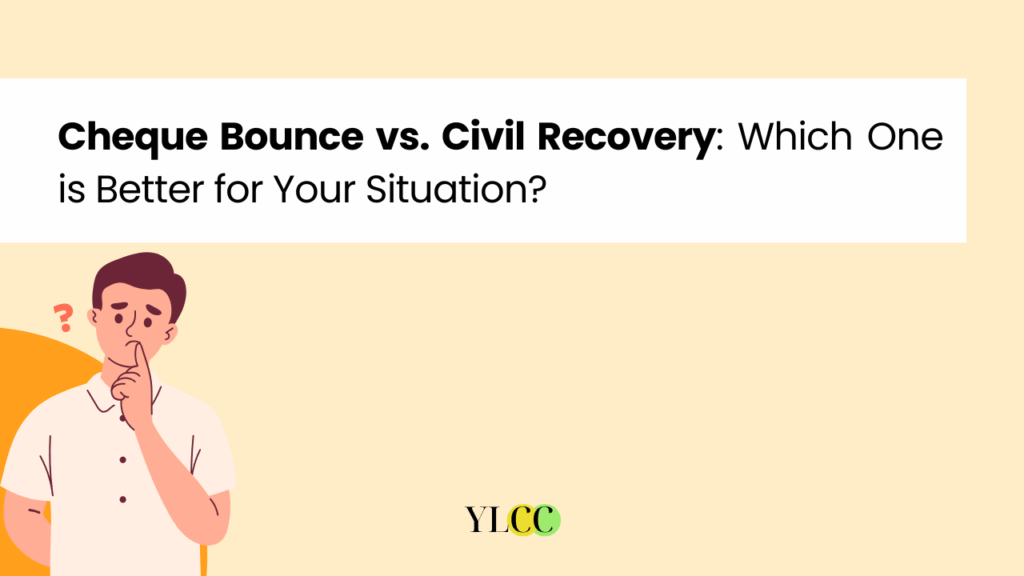
Introduction
When someone owes you money in India, whether you are an individual or a business, you essentially have two main legal paths to get it back. You can either go the ‘cheque bounce’ route, which is a criminal complaint under a law called the Negotiable Instruments Act, 1881 (specifically Section 138), or you can file a ‘civil recovery’ lawsuit under the Code of Civil Procedure of 1908. This civil option even includes a faster version called a summary suit. Both of these methods aim to help you recover what is owed, but they are quite different in terms of their legal nature, what they are trying to achieve, how they work, how long they take, and what the final outcome might be.
In India, where money matters can get pretty complicated, getting back what you are owed is a big deal for everyone, including individuals, businesses, and even banks. One of the common concerns is what to do when a cheque bounces. It is not just a minor hiccup; it can lead to some serious legal trouble. Luckily, Indian law offers clear ways for the aggrieved party to get their money back. This article is all about diving deep into these two main legal options:
- the criminal side, mainly covered by Section 138 of the Negotiable Instruments Act of 1881, which makes cheque bounce a crime if there are not enough funds; and
- the civil side, which includes different types of money recovery law-suits under the Code of Civil Procedure, 1908, like under Order 37 allowing summary suits. The objective herein is to give you a detailed comparison of these two approaches, explaining their legal rules, how they work step-by-step, what you can expect as an outcome, how much they might cost, and what kind of evidence you will need.
The Criminal Recourse (Section 138, Negotiable Instruments Act, 1881)
Understanding the Offence
Imagine, you receive a cheque, but it gets bounced post-deposition. It is not just an annoying financial hiccup; in India, a bounced cheque, especially one returned due to insufficient funds, is actually considered a criminal offense.
Section 138 of the Negotiable Instruments Act of 1881, deals with cheque bounce cases and provides a relevant remedy. The spirit behind this law is to make sure people can trust cheques as a reliable mode of payment, building confidence in financial dealings and discouraging anyone from writing cheques without enough funds or with sneaky intentions. The whole idea is to have a clear way to sort out these problems fairly, while also holding the person accountable if there is an issue. However, there are some considerations for the legal standing of the case under Section 138:
- It has to be for a real debt: The cheque must have been written to pay off a legitimate debt or other financial obligation, whether it is a full payment or just a part of it.
- Cash it on time: You need to present the cheque to the bank within its valid period, which is usually three months from the date it was issued.
- Insufficient funds (or similar issues): The bank must return the cheque unpaid because there was not enough money in the account, or because the amount exceeded what was agreed upon.
- Send a formal notice: You, as the person who received the cheque, must send a written demand notice to the person who wrote it within 30 days of finding out it bounced. This notice needs to clearly state the cheque details, why it bounced, and demand payment within 15 days.
- They still do not pay: The person who wrote the cheque must then fail to pay the amount within 15 days after receiving your notice.
It is pertinent to note that this Section 138 rule does not apply to cheques given as gifts or for charity, as those usually do not involve a legally binding obligation. While the law mainly talks about “insufficient funds”, courts have actually broadened this quite a bit. So, if a cheque bounces for reasons like “account closed”, “signature mismatch”, or even if it was a “security cheque” for an ongoing debt that was not paid, these can now also fall under Section 138.
This is because, at the end of the day, these reasons still mean there are not enough funds available for the payment. However, if a cheque bounces for purely technical reasons, like a small error in an endorsement or a mismatch between the written and numerical amounts, those generally are not covered. This expansion by the courts makes Section 138 a much stronger tool, stopping people from using technicalities to get out of paying what they owe and keeping the cheque system honest.
The Legal Process and Timeline
So, you have a bounced cheque. What is the actual legal journey you will embark on? A cheque bounce case under Section 138 of the Negotiable Instruments Act follows a pretty clear, step-by-step process:
- The Bank Tells You (Cheque Return Memo): It all starts when your bank informs you that the cheque did not go through. They will usually give you a “cheque return memo” that explains why it bounced.
- Send a Legal Notice (The Formal Demand): This is a significant step. Within 30 days of getting that memo, you must send a written legal notice to the person who wrote the cheque. This notice is not just a friendly reminder; it is a formal demand for them to pay the cheque amount within 15 days of them receiving it. Make sure your notice clearly states all the cheque details, why it bounced, and what legal trouble they will face if they do not pay up. While there is no super strict format, it is vital to include key information like names, addresses, cheque specifics (number, date, amount), the exact reason for dishonour, the return date, the 15-day notice period, and a clear mention of liability under Section 138.
You can send this notice in various ways, like registered mail, email, or even WhatsApp, as long as it follows the rules of the Information and Technology Act, 2000. Proving that you sent and they received (or should have received) this notice is super important for your case to move forward.
Here is a neat trick: if you accidentally missed that initial 30-day window to send the notice, but the cheque is still valid (usually three months from its issue date), you can actually deposit the cheque again. If it bounces a second time, you will get a fresh return memo, and that restarts your 30-day clock for sending the legal notice. This little manoeuvre can be a lifesaver if you slip up the first time, giving you another shot at getting your case going.
- File a Complaint: If, after all that, the person still has not paid within 15 days of getting your legal notice, you are now legally allowed to file a criminal complaint under Section 138 in the appropriate Magistrate’s court. You have one month from the end of that 15-day notice period to file this complaint. You will need to bring the original bounced cheque, the bank’s return memo, the legal notice you sent, and proof that it was received. You will also need to be there in person when you file it.
- Court Proceedings:
- Sworn Statement & Summons: The magistrate will look at your complaint, and if it seems like you have a case, you will give a sworn statement. If the court agrees, it will send out a summons for the accused person to show up. If they do not, an arrest warrant might even be issued.
- Appearance & Plea: The accused person is likely to be allowed bail after the appearance in the court. The court will ask the accused to plead to be innocent or guilty. If the accused pleads guilty, it could lead to immediate punishment (in the form of imprisonment or fine). If the accused pleads to be innocent, the case advances to the evidence stage.
- Evidence: Both sides will present their evidence, often through written statements (affidavits). This includes showing the bounced cheque, the dishonour memo, and copies of the legal notice. Witnesses might also be called, and then cross-examined by the other side’s lawyer.
- Arguments & Judgment: After all the evidence is on record, both parties will present the final arguments, which may include written submissions and references to precedents. The court will then make its decision and deliver a judgment.
- Execution of Judgment: If the court rules in your favour, the accused might be ordered to pay the cheque amount, plus interest and your legal costs. In some cases, the accused could even face imprisonment. The accused have a right to appeal to a higher court within 30 days, but the accused have to deposit at least 20% of the fine or compensation ordered by the trial court.
Evidentiary Requirements and Presumptions
To successfully file and pursue a cheque bounce case, the payee typically needs to possess and produce specific key documents:
- The original bounced cheque.
- The cheque return memo from the bank, clearly citing the reason for dishonour.
- A copy of the legal notice sent to the drawer, demanding payment.
- Proof of dispatch and receipt of the legal notice by the drawer.
- An affidavit in support of the complaint.
- Any other evidence relevant to the facts of the case, such as invoices or underlying agreements, though the primary focus is on the cheque itself. Bank statements or passbooks proving insufficient funds in the drawer’s account are also crucial.
The Monetary Recourse (Code of Civil Procedure, 1908)
Overview of Civil Recovery Mechanisms
Civil recovery suits under the Code of Civil Procedure (CPC), 1908, provide a direct and efficient legal remedy for the recovery of money owed, focusing solely on the monetary realisation of the debt. This route is essential for situations where financial obligations go unmet and direct financial restitution is sought.
Two primary types of civil recovery mechanisms are available:
- Ordinary Civil Suits: These are general suits for money recovery governed by the comprehensive provisions of the Code of Civil Procedure, 1908. They involve a detailed, multi-stage process from institution to execution. Ordinary civil suits are suitable for a wide range of monetary claims, including unpaid loans, unpaid invoices, breach of contract, or non-payment of rent. They offer flexibility for complex cases that may involve extensive evidence or multiple parties.
- Summary Suits (Order 37 CPC): Order 37 of the CPC provides a specialised, swift, and powerful route to recover debts. Its key distinguishing feature is that the defendant is generally not permitted to defend the claim unless they obtain prior permission (leave to defend) from the court. This mechanism is designed to significantly speed up the litigation process and benefits genuine claimants by preventing delaying tactics by the defendant. Summary suits are particularly applicable for various types of claims where the liability is clearly documented, such as recovery based on written contracts, unpaid invoices or bills, dishonoured cheques, loans advanced via promissory notes, and commercial disputes with documented liability for payment. This streamlined procedure is applicable to both individuals and business entities.
The Legal Process and Timeline
The legal process for civil recovery suits varies depending on whether an ordinary civil suit or a summary suit under Order 37 of CPC is chosen.
The following is the procedure for Summary Suits (Order 37 of CPC):
- Drafting the Plaint: The plaint (formal complaint) must be meticulously drafted, clearly mentioning the nature of the debt, including all relevant documentary proof (e.g., invoice, agreement, promissory note, dishonoured cheque), and specifying the relief sought (principal amount + interest).
- Filing and Summons: The suit has to be filed at the appropriate forum (District Court or High Court), depending on the pecuniary jurisdiction (e.g., in Delhi, District Courts handle suits up to Rs. 20 lakhs, while High Courts handle those above Rs. 20 lakhs) (see here). The court then issues a summons to the defendant.
- Leave to Defend: Upon receiving the summons, the defendant must seek “leave to defend” from the court within 10 days. If the defendant fails to seek leave, or if leave is sought but not granted by the court (e.g., if the defence appears frivolous or lacks merit), judgment is passed.
- Decree and Execution: If judgment is passed in favour of the Plaintiff, a monetary decree is issued. This decree can then be executed through various legal means, such as attaching the property or salary of the Defendant. A successful case study highlights a decree being passed within 4 months, leading to full recovery via property attachment.
Procedure for Ordinary Civil Suits:
- The suit commences with the plaintiff filing a plaint (formal complaint) at the court.
- The court issues a summons to the defendant, accompanied by a copy of the plaint.
- The Defendant appears in court on the fixed date.
- The Defendant files a written statement outlining their defence and may also include set-off claims or counter-claims. All documents relied upon for defence must be listed and presented to the court.
- The court, after reviewing the pleadings and potentially interrogating parties or witnesses, frames the specific issues (points of dispute) that need to be proven during the trial.
- Both the Plaintiff and Defendant present their evidence, including documentary proof and witness testimony. This stage involves examination-in-chief and cross-examination of witnesses.
- After all evidence is presented and cross-examined, lawyers for both sides present their final arguments to the judge. The court then delivers its judgment.
- If the judgment is in favour of the Plaintiff, a decree is passed, which is then enforced through execution proceedings.
Obtaining a favourable judgment or decree in a civil suit is only the preliminary step towards actual debt recovery. The subsequent execution of the decree, which involves processes like attachment and sale of assets or salary, can be a separate, often challenging, and time-consuming legal battle. This phase requires continued legal effort and diligence from the creditor to ensure the actual realisation of the money. Furthermore, the Civil Procedure Code provides multiple avenues for defendants against whom ex parte decrees (judgments passed without their full defence, often in summary suits if leave to defend is not granted) have been passed. These remedies include filing an application to set aside the ex parte decree (under Order 9 Rule 13 CPC), filing an appeal against the decree [under Section 96(2) CPC], or seeking revision or review of the judgment.
Evidentiary Requirements
For a civil recovery suit, particularly a summary suit under Order 37 of CPC, the evidentiary requirements are primarily documentary.
Key documents include:
- The original agreement or contract that establishes the terms of the financial obligation.
- Invoices or bills that serve as proof of goods supplied or services rendered and the amount due.
- A demand notice, while optional, is highly recommended as it demonstrates that the claimant attempted to recover the dues before resorting to legal action.
- Proof of delivery of goods or services, confirming that the claimant fulfilled their part of the agreement.
- Bank statements clearly showing non-payment or the outstanding financial obligation.
- Legal representation documents are also necessary for the legal team to represent the claimant in court.
Cheque Bounce vs. Civil Recovery: Which is Better?
The decision between pursuing a cheque bounce case and a civil recovery suit is a strategic one, heavily influenced by the specific circumstances of the debt and the creditor’s objectives.
When someone owes you money and gives you a cheque that bounces, or simply does not pay back a loan, you have a few legal options. This guide explains the two main paths you can take in India: a cheque bounce case (under the Negotiable Instruments Act) or a civil case for debt recovery.
What’s the Big Difference?
Think of it this way:
- Cheque Bounce Case (Criminal): This is like calling the police when someone breaks a rule. It is about punishing the person who gave you the faulty cheque and making sure people trust cheques. While you might get your money back, the main goal is to penalise the defaulter.
- Civil Debt Recovery (Civil): This is like going to a referee to settle a dispute. It is purely about getting your money back, plus any interest or costs. There is no criminal punishment involved against the person who owes you money.
Why Choose a Cheque Bounce Case?
Even though it is a criminal case, it is often a powerful way to get your money back. Why? Because the person who bounced the cheque faces serious consequences, like potential jail time or heavy fines. This pressure often makes them pay up quickly to avoid criminal conviction.
How Do They Work? (The Process)
- Cheque Bounce Cases: While there are strict deadlines to start the process, the whole thing can still take anywhere from 6 months to over 3 years. It depends on how busy the courts are and if there are appeals involved.
- Civil Debt Recovery:
- Summary Suits: These are designed to be faster than regular civil cases, especially if the person who owes you money does not have a strong defense. They can be much quicker.
- Ordinary Civil Suits: These are the slowest option, involving many steps and taking a long time to resolve.
Complexity and Rules
- Cheque Bounce Cases: These follow strict criminal court rules. This can involve things like bail, formal pleas, and even arrest warrants. You have to follow all the specific conditions very carefully.
- Civil Debt Recovery: These follow civil court rules. While they can be detailed, summary suits are simpler for the person trying to get their money back. Generally, there is less risk of the debtor being arrested or imprisoned.
Proving Your Case:
- Cheque Bounce Cases: The law assumes that a bounced cheque means money is owed. It is up to the person who bounced the cheque to prove they ‘do not’ owe the money. This makes it easier for you to start your case.
- Civil Debt Recovery: You generally have to prove that the money is owed. However, if you have clear documents (like contracts or invoices), especially in summary suits, it can make your case much faster and simpler.
What About the Money? (Costs Involved)
- Cheque Bounce Cases: These are usually quite low, often just a few hundred rupees. Lawyer fees can range from ₹5,000 to ₹50,000.
- Civil Debt Recovery: These fees are based on the amount of money you are trying to recover. The more you claim, the higher the fee, calculated as a percentage of the amount. Lawyer fees are generally higher for civil cases because they can be longer and more complicated, especially for ordinary civil suits. Fees might be a percentage of the money recovered or based on different stages of the case.
How to Decide Which Path to Take?
Choosing the best legal strategy depends on your specific situation. Here are some key questions to ask yourself:
- Bounced Cheque?: If you have a valid, bounced cheque, a cheque bounce case is a very strong and direct option.
- Written Agreement?: If the debt is clearly shown in a contract, invoice, or promissory note, a summary civil suit is a great choice because it is streamlined.
- Complex Debt?: If the debt involves many transactions or needs a lot of spoken evidence, an ordinary civil suit might be better, even if it takes longer.
- Do You Have Documents?: Having strong, undisputed documents (like the original cheque, written contracts, invoices, bank statements, or clear communication records) makes your case much stronger and faster in both types of cases. This is especially true for summary suits, where missing documents can really slow things down.
- What About the Debtor?:
- Will they pay under pressure?
- Do they have assets?
- Was it fraud?
- Is the Debt Too Old? (Statute of Limitation): This is a crucial point. If the debt is too old (time-barred) under the law, you generally can not file a cheque bounce case. This is because a cheque bounce case requires a “legally enforceable debt”.
However, for civil recovery, even if a debt is time-barred, it might be possible to revive it if the debtor acknowledges it in writing or makes a partial payment before the time limit expires, or if they make a new written promise to pay the old debt.
In summary, if you have a bounced cheque, the criminal route under Section 138 of the Negotiable Instruments Act is a powerful option due to its deterrent effect. If the debt is not based on a cheque, or if the cheque-related debt is time-barred, civil recovery (especially a summary suit with strong documentation) is your primary avenue for getting your money back. Always consider the specifics of your situation and consult with a legal professional to make the best decision.
YLCC would like to thank Nikunj Arora for his valuable insights into this article.






